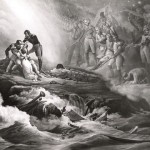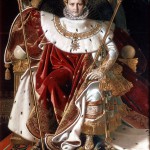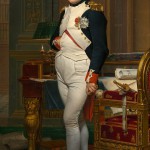Paintings : 5
-
 Painting“Allegory of the exile and death of Napoleon I on St Helena” or “Napoleon’s tomb”This small black and white postcard is a photograph of a painting (now lost) by Horace Vernet, painted in July 1821 immediately after learning of the death, two months earlier, of Napoleon I. Vernet was a fervent Bonapartist and his best-known Napoleonic works are Napoleon I reviewing…
Painting“Allegory of the exile and death of Napoleon I on St Helena” or “Napoleon’s tomb”This small black and white postcard is a photograph of a painting (now lost) by Horace Vernet, painted in July 1821 immediately after learning of the death, two months earlier, of Napoleon I. Vernet was a fervent Bonapartist and his best-known Napoleonic works are Napoleon I reviewing… -
![Painting by Steuben [the life of Napoleon in eight hats]](https://www.napoleon.org/wp-content/thumbnails/uploads/2018/09/rebeccayoungfondation-napoleon_2018-1735-tt-width-150-height-150-crop-1-bgcolor-ffffff-lazyload-0.jpg) PaintingPainting by Steuben [the life of Napoleon in eight hats]
PaintingPainting by Steuben [the life of Napoleon in eight hats]Inscribed on the back of the painting : donné par M. Steuben/à Mad. Amable/Tastu/ le 14 février 1826. [Given by M.[onsieur] Steuben/ to Mad.[ame] Amable Tastu/ on 14 February 1826] The artist Charles de Steuben, a pupil during the Empire period of David’s (let us not forget, that Jacques-Louis was once member of the Jacobin […]
-
 PaintingNapoleon I on his Imperial Throne
PaintingNapoleon I on his Imperial ThroneThis painting, one of the best-known representations of Emperor Napoleon I, was Ingres’ second portrait of Napoleon Bonaparte. The promising young student of David, Jean-Auguste-Dominique Ingres (1780-1867), was one of several artists to receive an official commission to portray Napoleon dressed in one of the many different Coronation robes that the Emperor wore during the […]
-
![Napoleon emerging from his tomb [Allegory of the transfer of Napoleon’s mortal remains from St Helena to Paris]](https://www.napoleon.org/wp-content/thumbnails/uploads/2016/04/1500Napoleon_sortant_de_son_tombeau-tt-width-150-height-150-crop-1-bgcolor-ffffff-lazyload-0.jpg) PaintingNapoleon emerging from his tomb [Allegory of the transfer of Napoleon’s mortal remains from St Helena to Paris]
PaintingNapoleon emerging from his tomb [Allegory of the transfer of Napoleon’s mortal remains from St Helena to Paris]The title of this work is a quotation from the Emperor’s last will and testament, indeed it is one of its most quoted lines: “It is my wish that my ashes may repose on the banks of the Seine, in the midst of the French people, whom I have loved so well”. For this […]
-
 PaintingNapoleon in his study at the Tuileries
PaintingNapoleon in his study at the TuileriesOn 3 August, 1811, the wealthy Scot, Alexander, Marquis of Douglas – who was to become the tenth Duke of Hamilton in 1819 – wrote to David commissioning from him a portrait of Napoleon. “… You have graciously chosen my brush through which to transfer onto canvas the features of the Great Man and to […]

